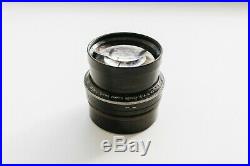
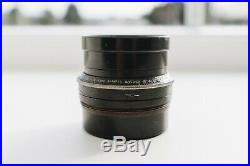
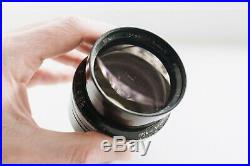
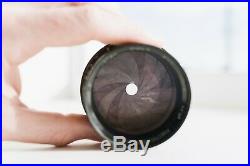
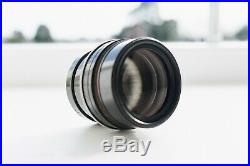
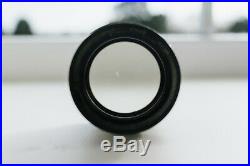
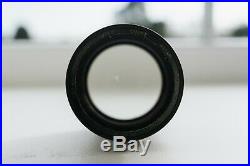

Taylor Hobson Cooke Optics. Anastigmat Aviar 254mm 10 f/4.5 Lens. Not 100% on the exact age of this very rare and beautiful lens, but research puts it at between 1920-30. According to the excerpt from the Cooke Optics website, this lens was originally developed as an aviation reconnaissance lens for use during WWI, and was so highly regarded that it was put into production for general photography use thereafter. See below for an excerpt from the Cooke Optics website. As usual, there are some dust particles, a small scratch on the front element (pictured), and some small patches of fungus. Most of these could be remedied by a service. Projection tests in a dark room do not render any of these issues visible to the naked eye. And an incredibly sharp lens to boot. Excerpt from Cooke Optics Website. Series II, f/4.5 AVIAR. Based on the original World War I Aviar reconnaissance lens, adopted by the R. In 1916; the first British lens to compete successfully against the best German lens in use for aerial photography. Four separate glasses, no cement. Two outer elements are convex and inner elements are double concave. 113590, Arthur Warmisham, designer. The importation of German and French glass as used for making photographic lenses in this country is now nearly negligible. Before the War, lens-makers depended largely upon the Continent for their glass supply, and because the first anastigmat lenses were made thirty odd years ago from certain glasses produced at the Jena works in Germany, Jena glass gained a reputation among photographers which it upheld for some years prior to the war. With the onset of World War I, German and French glass, readily available before the war, was no longer accessible. At the same time there arose an urgent demand for special types of lenses, binoculars, range-finders, gun sights and other optical instruments. At first, the British government satisfied the need by purchasing German lenses from the public, then TT&H was suddenly made responsible by the Government for the principle supply of optical glass. Arthur Warmisham designed a new Cooke lens British patent no. 113590 that was accepted as superior in performance to foreign lenses for aerial reconnaissance. The lenses were developed in various sizes and diaphragm apertures to meet the every-changing needs of the Air Force, while telephoto lenses of high magnification for distant views were produced for the same Government Department. The first sample was tested in a stereo camera against the best foreign lens of similar focus and aperture ever produced for this class of work. When President of the R. [Royal Photographic Society], in 1916, made the following statement in his opening address about the comparative test that was made: –I may say that plates were exposed simultaneously at an altitude of several thousand feet with a Zeiss and the new Cooke lens, of equal foci, the latter now known as the Aviar: the plates received identical exposures and development. I was subsequently asked to give an opinion upon the quality of the lenses used in making the negatives, not knowing what lenses had been used. Very little examination was necessary before I unhesitatingly selected one negative as being superior to the otherthat one was made with the British Lens. The Leicester firm deserves the congratulations of British photographers and the public, for having removed the stigma from British Science and Manufacture that English Lenses were inferior to German, especially at a time when there are war difficulties and shortage of suitable optical glass. When the war ended in 1918, Great Britain was making the finest optical glass in the world and that status was maintained for many years. In 1919, King George and Queen Mary made an official visit to the TT&H factory in acknowledgement of the companys contribution to the war effort. Their majesties toured the factory and were introduced to some senior staff and long serving employees. The Leicester Mercury newspaper reported that their majesties displayed great interest in both the technical and human sides of the work with several of the royal party commenting that they had never before seen work of such interest. The Aviar lens was then adapted for general photography in 1924, becoming one of the most favoured of all high-grade anastigmats among both amateurs and professionals and was especially suited for use on Graflex and other reflex cameras. It was produced in various focal lengths until about 1962. These lenses are used extensively in Cinema Studios for Stills, where critically sharp definition is essential. On request they can be supplied corrected for use with Mercury vapour lighting for enlargers. All Aviar lenses enlarge from plates exceeding the sizes for which they are normally listed. In a 1962 advert, Burke & James, Inc. The item “Cooke Anastigmat Aviar 254mm 10 f/4.5 Lens Large Format Vintage VERY RARE” is in sale since Friday, July 19, 2019. This item is in the category “Cameras\Vintage Movie & Photography\Vintage Lenses”. The seller is “mitcholga” and is located in Trafalgar, VIC. This item can be shipped worldwide.
- Brand: Taylor-Hobson Cooke Optics
- Model: Anastigmat Aviar
- Era: 1920s
- Focal Length: 254mm
- Type: Aviar
- Maximum Aperture: f/4.5

